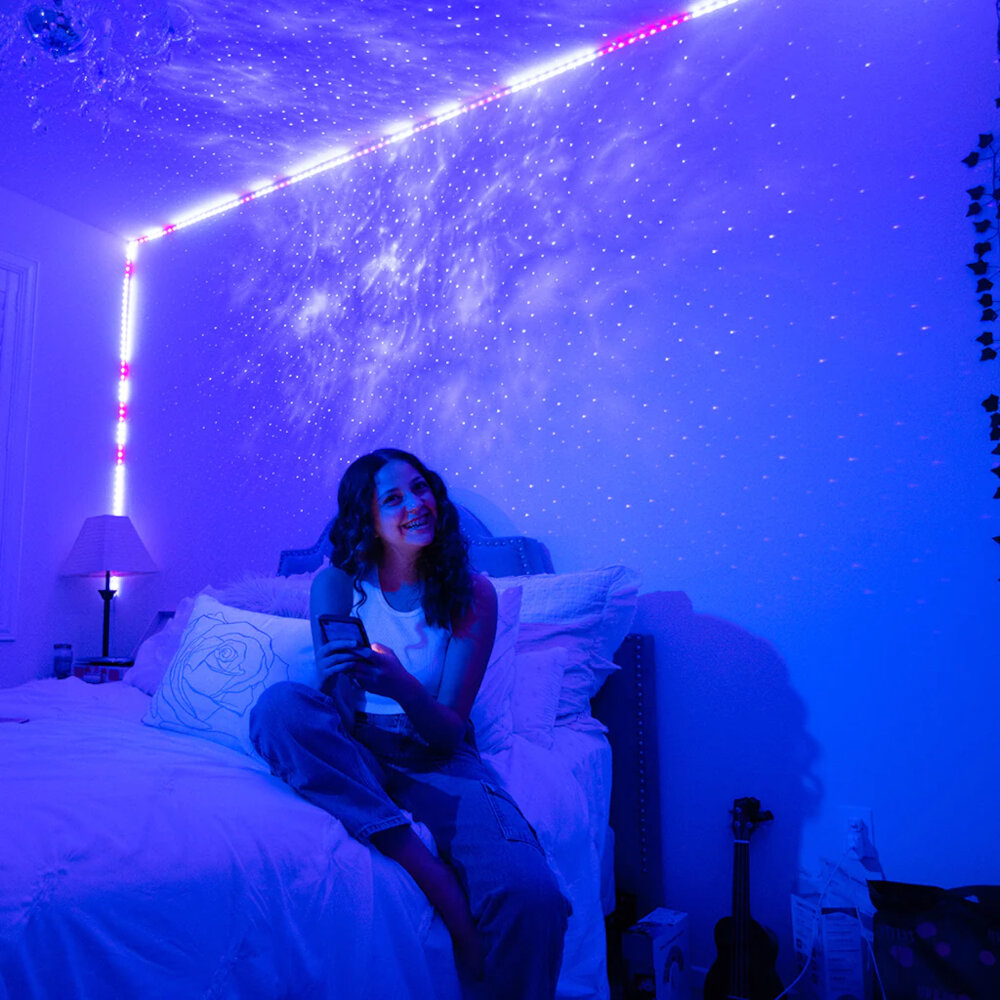Why LED Lights Glow When Off Exploring the Science Behind the Phenomenon

Have you ever noticed that LED lights sometimes glow even when they are turned off? This phenomenon has puzzled many people and raised questions about the science behind it. LED lights are known for their energy efficiency and long-lasting lifespan, but what causes them to produce light when they are not in use?The answer to this question lies in the way LED lights work. LED lights are made up of a semiconductor material that emits light when an electric current passes through it. When the LED light is turned off, a small amount of current may still flow through the circuit, causing the LED to emit a faint glow. This phenomenon is known as \phantom voltage\ and is a common occurrence in many electronic devices. However, the glow from LED lights is much more noticeable due to their bright and vibrant colors. Let’s dive deeper into the science behind why LED lights glow when off.
The phenomenon of LED lights glowing when switched off is an intriguing occurrence that has puzzled many people. This phenomenon is caused by a phenomenon known as \leakage current,\ which is a small amount of electricity that flows through the LED even when it is turned off. When the LED is turned off, the residual energy in the circuit is not enough to power the light, but it is sufficient to produce a faint glow. The leakage current is a result of the internal components of the LED light and the overall design of the circuitry. While this phenomenon may seem unusual and even concerning to some, it is a common occurrence and is not a cause for alarm.
Understanding the science behind a phenomenon can provide valuable insights into its nature and behavior. In the case of LED lights glowing when turned off, knowledge of the underlying scientific principles can help us comprehend why this occurs and how to prevent it. By delving into the molecular and physical processes that occur within the LED bulb, we can identify the factors that contribute to the unexpected glow, such as residual charges and thermal energy. Armed with this knowledge, we can make adjustments to the design and function of LED lights, improving their efficiency and reducing their environmental impact. Additionally, a deeper understanding of the science behind LED lights can enable us to develop new technologies and applications that harness their unique properties, such as their low power consumption and long lifespan. Overall, exploring the science behind LED lights is key to unlocking their full potential and ensuring their optimal performance.
This article delves into the fascinating phenomenon of LED lights glowing when they are switched off. The author explores the science behind this occurrence, and reveals that it is due to a process called \leakage current.\ The article explains that all electronic devices experience a small amount of leakage current, which is the flow of electricity that occurs even when the device is supposed to be off. The author goes on to explain how this process specifically affects LED lights, and offers several potential solutions for those who are bothered by the glow. With its engaging writing and clear explanations, this article is a must-read for anyone who has ever been curious about the science behind everyday phenomena.
What Causes LED Lights to Glow When Off

LED lights are widely used in homes, offices, and public spaces due to their energy efficiency and long lifespan. However, one peculiar phenomenon experienced by many LED users is the glowing of the lights even when they are switched off. This phenomenon is commonly known as \ghosting\ or \phantom lighting,\ and it occurs due to a few different reasons. One cause of LED lights glowing when switched off is the use of dimmer switches. LED lights require a specific type of dimmer switch that is compatible with their electronic circuitry. If the wrong type of dimmer switch is used, it can cause the LED lights to glow when switched off. This is because the dimmer switch is not fully turning off the LED lights’ power supply, which causes a small current to flow through the LED lights, making them glow. Another cause of LED lights glowing when switched off is the residual charge left in the LED driver or capacitor. Even after the LED lights are switched off, the LED driver or capacitor can still hold a small amount of electric charge, which can cause the LED lights to glow. This phenomenon is more common in older LED lights, as newer models are designed to discharge the electric charge more efficiently.
The phenomenon of LED lights glowing when turned off might seem puzzling, but there is a scientific explanation behind it. LEDs contain a semiconductor material that can store electrical charge even when the power is turned off. This happens because of the presence of a small amount of current leakage that flows through the circuit even when the switch is off. The leakage current is not enough to power the LED, but it is sufficient to cause the semiconductor material to emit a faint light. This is known as the \ghosting effect\ and is a common occurrence with LED lights. Although it may be a nuisance to some, it is not harmful and can be prevented by using a switch with a higher quality or by adding a resistor to the circuit.
Capacitors are essential components of LED lights as they help regulate the flow of electric current, which is crucial for their proper functioning. They can store electric charge and discharge it when required, which enables them to act as filters for the electrical signals. Capacitors in LED lights help prevent flickering, which can be distracting and cause eye strain, by stabilizing the voltage and smoothing out any fluctuations in the power supply. They also help reduce electromagnetic interference, which can affect other electronic devices in the vicinity. Without capacitors, the LED lights would not be able to provide stable and reliable illumination, and their lifespan would be shorter.
The charging and discharging process is a fundamental concept of electrical engineering that explains how energy is stored and released in an electrical circuit. When a battery is charged, it stores energy by converting electrical energy into chemical energy. This process involves the movement of charged particles, or ions, from one electrode to another, where they react with the electrode material to create a chemical reaction. During the discharging process, the opposite reaction occurs, where the chemical energy is converted back into electrical energy, and the energy is released to power a device. This process is essential for the operation of many electronic devices, including LED lights, as it allows the stored energy to be used when needed.
Residual current is the flow of electric current that persists in a circuit even when all the appliances and switches are turned off. In the context of LED lights, residual current can produce a faint glow, referred to as ghosting, when the light is switched off. This phenomenon occurs when the residual current flows through the LED’s semiconductor material, which has a low resistance to electricity. The impact of residual current can be detrimental to the lifespan of LED bulbs, as it can cause overheating and lead to premature failure. Additionally, residual current can also pose a safety hazard, especially in damp environments where the current can leak to the ground and potentially cause electric shock. Therefore, it is essential to identify and address the cause of residual current to ensure the longevity and safety of LED lighting systems.
The Effects of Residual Current on LED Lights

LED lights are known for their energy efficiency and long lifespan, making them a popular choice for lighting solutions. However, one of the most common complaints about LED lights is their tendency to glow when turned off. This phenomenon is caused by residual current, which is the small amount of electrical current that continues to flow through the circuit even when the switch is turned off. The effects of residual current on LED lights can vary depending on the quality of the LED driver and the wiring of the circuit. In some cases, it can cause the LED lights to flicker or emit a dim glow, while in other cases, it may not have any noticeable effect. Residual current is a common issue with all types of electrical circuits, not just LED lights. It is caused by the capacitance and inductance of the wires and components in the circuit, which can store electrical charge even when the circuit is not powered. In LED lighting systems, residual current can be particularly problematic because LEDs require very little current to operate. This means that even a small amount of residual current can be enough to cause the LEDs to glow. To prevent this problem, it is important to use high-quality LED drivers and wiring that are designed to minimize residual current. Additionally, adding a load resistor to the circuit can help to reduce the effects of residual current and prevent LED lights from glowing when turned off.
Residual current, also known as leakage current, can have a significant impact on LED lights, causing them to glow even when they are turned off. This is because residual current flows through the circuitry of the LED light, causing the diodes to emit a faint glow. The amount of residual current required to cause this effect can be very small, which is why LED lights are particularly susceptible to this phenomenon. While this may not be a major concern for most people, it can be a nuisance in certain situations, such as in bedrooms where even a small amount of light can disrupt sleep. To prevent this from happening, it is important to ensure that the wiring in your home is properly grounded and that any residual current is minimized.
Residual current is the amount of electrical current that flows through a circuit when it is supposed to be off. Several factors can contribute to residual current, including the quality of the circuit breaker, the age of the wiring, and the presence of other electrical devices on the same circuit. A circuit breaker that is not functioning correctly may allow a small amount of current to pass through even when the switch is in the off position. Aging wiring can also contribute to residual current, as the insulation may degrade over time and allow small amounts of current to leak through. Additionally, other devices on the same circuit, such as appliances or electronics, can create electromagnetic fields that induce current in the wiring, leading to residual current.
Residual current, also known as leakage current, can pose significant risks in electrical systems. It occurs when electricity leaks from the intended circuit path, potentially leading to dangerous electrical shocks or fires. LED lights, as well as many other electrical devices, can produce residual current when they are switched off, causing them to glow. This phenomenon can indicate the presence of residual current and highlight the potential safety hazards associated with it. It is essential to ensure that electrical systems are properly installed and maintained to prevent residual current and protect against electrical accidents. Regular safety checks and the use of residual current devices (RCDs) can help mitigate these risks and ensure the safe operation of electrical systems.
How to Prevent LED Lights from Glowing When Off

LED lights are widely used in modern homes and offices for their energy efficiency and durability. However, one of the most common problems experienced by LED light users is the glowing of the lights when they are supposed to be off. This phenomenon is caused by a small amount of electric current that continues to flow through the LED even when the switch is turned off. Fortunately, there are several ways to prevent LED lights from glowing when off. One of the most effective ways to prevent LED lights from glowing when off is by using an LED dimmer switch. This type of switch is specifically designed for use with LED lights and can help to reduce the amount of electric current that flows through the LED when it is turned off. Additionally, you can install an inline resistor into the circuit to limit the amount of current flowing through the LED. This will reduce the voltage at the LED and prevent it from glowing when off. It is important to ensure that the resistor is correctly sized for the LED and that it is installed correctly to avoid any potential safety issues. By taking these steps, you can prevent LED lights from glowing when off and enjoy the many benefits of energy-efficient lighting without any unwanted side effects.
There are various ways to prevent LED lights from glowing when turned off. One of the most straightforward solutions is to replace the existing switch with a dimmer switch that is compatible with LED lights. Alternatively, you can install a snubber circuit, which is a device that reduces voltage spikes and transients, preventing the LED light from glowing. Another option is to use a relay or optocoupler to isolate the LED light from the circuit, cutting off the power supply completely when the switch is turned off. Additionally, you can try changing the wiring of the circuit or adding a capacitor to absorb voltage spikes. Ultimately, finding the most effective solution depends on the specific circumstances of your LED light and its circuitry.
Electricians play a crucial role in addressing the issue of LED lights glowing when they are supposed to be off. Firstly, they can ensure that the wiring and electrical connections are up to code and properly grounded. This can prevent any stray voltage or current from causing the LED lights to glow. Additionally, they can advise on the selection of high-quality dimmer switches and LED bulbs that are specifically designed to work together. This can help to eliminate any compatibility issues that may be causing the glowing effect. Furthermore, electricians can also perform regular maintenance and inspections to identify any potential issues before they become a problem. By working closely with electricians, individuals and businesses can ensure that their LED lighting systems are safe, functional, and efficient.
Using high-quality LED lights is of utmost importance due to several reasons. Firstly, they are energy-efficient and consume less electricity than traditional bulbs, resulting in lower energy bills and a reduced carbon footprint. Secondly, high-quality LED lights offer better illumination and brightness, and they are available in a range of colors, shapes, and sizes. These lights have a longer lifespan than traditional bulbs and require little maintenance, making them a cost-effective option in the long run. Additionally, high-quality LED lights emit less heat and are safer to use than traditional bulbs, reducing the risk of fire hazards. Overall, investing in high-quality LED lights can offer a range of benefits, including energy savings, better illumination, and improved safety.
LED lights are commonly known for their energy efficiency and longevity, but they can also exhibit a peculiar behavior of glowing even when they are turned off. This phenomenon, known as \ghosting\ or \phantom lighting,\ occurs due to the residual voltage stored in the wiring and capacitors of the LED circuit. When the LED is switched off, the voltage is not entirely dissipated and can accumulate over time, causing a faint glow. The phenomenon is more noticeable in dimly lit environments or when multiple LEDs are connected in series. While it may seem like a waste of energy, the amount of power consumed is negligible, and there is no harm to the LED or the circuitry. However, this phenomenon can be mitigated by using specialized LED drivers that discharge the residual voltage or by adding a switch to the circuit to break the current flow completely.
In the world of science, curiosity is what drives us to learn more about the natural phenomena that surround us. Understanding the science behind any phenomenon is crucial because it enables us to make sense of the world and its workings. Without this understanding, we would be left in the dark, unable to make informed decisions or to predict the outcomes of any given situation. In the case of LED lights, knowing why they continue to glow when switched off not only satisfies our curiosity but also helps us to optimize their use and avoid unnecessary energy consumption. Therefore, investing in the science behind the phenomenon is essential in expanding our knowledge and enhancing our lives.
In conclusion, LED lights glowing when turned off can be a frustrating and confusing phenomenon, but by taking some simple steps, it can be prevented. Firstly, using a high-quality LED driver with low standby power consumption can help reduce the risk of ghosting. Secondly, ensuring that the wiring is properly grounded and using a surge protector can also help prevent this issue. Additionally, using a light switch with a neutral wire can help eliminate stray voltage. Furthermore, it is important to note that LED lights are sensitive to fluctuations in voltage, so it is crucial to maintain a consistent voltage supply. Overall, by taking these preventative measures, you can enjoy the benefits of LED lighting without the annoyance of ghosting.
Conclusion

In conclusion, the phenomenon of LED lights glowing when turned off is a fascinating example of the intricate workings of modern technology. While it may seem like a mystery at first, a deeper understanding of the scientific principles involved reveals a complex but understandable process. Factors such as residual voltage, phosphorescence, and the presence of electromagnetic fields all contribute to this phenomenon. As we continue to develop and refine LED technology, it is likely that we will gain even more insight into the underlying mechanisms that drive this and other related phenomena. In the meantime, understanding the science behind LED lights that glow when off can help us better appreciate the intricate and fascinating world of modern technology.




